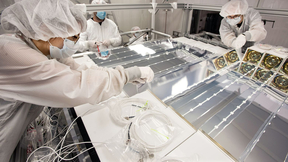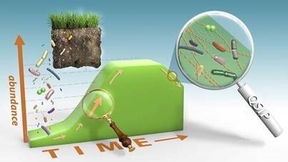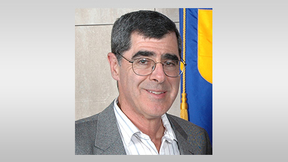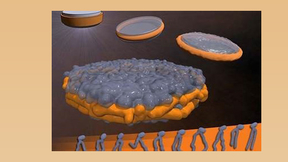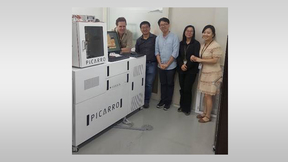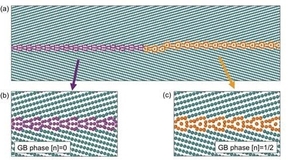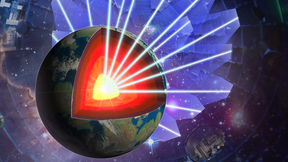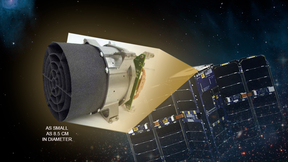Back
Physical and Life Sciences
PROSPECTing for antineutrinos
The Precision Reactor Oscillation and Spectrum Experiment (PROSPECT) has completed installation of a novel antineutrino detector that will probe the possible existence of a new form of matter -- sterile neutrinos. PROSPECT, located at the High Flux Isotope Reactor (HFIR) at the Department of Energy’s Oak Ridge National Laboratory (ORNL), has begun taking data to study…
Studying population dynamics in diverse microbial communities
Ecological research focuses on understanding how population-level dynamics—such as the growth rate of a particular population of microbes—contribute to ecosystem-level processes. Ecosystem scientists researching climate change often study the role of microbes in the carbon cycle, for example, so knowing how quickly they grow is a fundamental metric to reaching that…
Cohen honored with computational plasma physics award
Retiree Bruce Cohen (PHYS) has been selected as the recipient of the 2018 IEEE Nuclear and Plasma Sciences Society’s Charles K. Birdsall Award for “contributions to the numerical simulation of plasmas, particularly multiple time-scale methods, and to their application to diverse plasma physics problems, from laser–plasma interactions to tokamaks.” The Birdsall Award…
Optimizing nanoparticles for in vivo applications
For several years, Lawrence Livermore has been developing a novel class of nanoparticles for biomedical applications that are highly biocompatible and offer advantages that other nanoparticle types do not. These nanoparticles, termed nanolipoprotein particles (NLPs), consist of a phospholipid bilayer stabilized by an apolipoprotein scaffold protein and are lab-made…
A warm look at water's structure
Boiling water traditionally involves adding energy to molecules by conduction, convection or thermal radiation. But Lawrence Livermore National Laboratory (LLNL) scientists and collaborators have figured out a way using an X-ray Free Electron Laser (XFEL) to heat water to temperatures above 100,000 K (179,540 degrees Fahrenheit) and pressures above 1Mbar (1 million times…
Lab research in fuels, engines in the spotlight
The Department of Energy’s (DOE) Co-Optimization of Fuels & Engines (Co-Optima) initiative recently highlighted the work that Lawrence Livermore National Laboratory (LLNL) scientists have performed on models of high-performance fuels to see how they would perform in advanced internal combustion engines. The Co-Optima initiative aims to simultaneously transform…
Antimicrobial resistance on the International Space Station
In an effort to minimize antimicrobial resistance (AMR) threat to astronauts, who may be immunocompromised and thus at a greater risk of infection from pathogens, a comprehensive study of the International Space Station “resistome” was conducted by a team of scientists from the Jet Propulsion Laboratory, LLNL, the Naval Medical Research Center, and AlloSource. Using a…
Prototype cavity ring-down spectroscopy instrument for 14C measurements
A commercial cavity ring-down spectroscopy (CRDS) instrument for the measurement of 14C in biological studies has been developed through a Cooperative Research and Development Agreement between Picarro, Inc. and Lawrence Livermore National Laboratory—where much of the initial research and development was performed. CRDS is a highly sensitive optical spectroscopic technique…
Surprising grain boundary structures found in refractory metals
Grain boundaries govern many of the properties of engineering materials, but until recently, computational techniques were not sufficiently powerful to predict grain boundary properties at elevated temperature, where they can undergo transitions from one structure to another. The study of grain boundary phase transitions is in its infancy, largely dominated by experiments…
Additive manufacturing advances K-9 training
Additive manufacturing (AM) has gone to the dogs, thanks to Lawrence Livermore National Laboratory’s (LLNL’s) new approach to K-9 training materials. The process prints 3D objects that contain trace amounts of nonreactive explosives, resulting in several advantages for K-9s and their handlers. Chemist John Reynolds leads a team of LLNL scientists and engineers who recently…
Record experiments probe exoplanetary cores
Using high-powered laser beams, iron-silicon alloys have been compressed to unprecedented pressures corresponding to the center of a three-Earth-mass extrasolar planet. The resulting measurements of crystal structure and density provide new insights into the nature of the deep interiors of the large, Earth-like planets that have been discovered throughout our galaxy. The…
Americans ramp up use of solar, wind energy
Americans used more solar and wind energy in 2017 compared to the previous year, according to the most recent energy flow charts released by Lawrence Livermore National Laboratory (LLNL). Overall, energy consumption by the residential and commercial sectors dropped a bit. Each year, the Laboratory releases energy flow charts that illustrate the nation's consumption and use…
LLNL maps out deployment of carbon capture and sequestration for ethanol production
To better understand the near-term commercial potential for capturing and storing atmospheric carbon dioxide (CO2), researchers from Lawrence Livermore National Laboratory (LLNL) have mapped out how CO2 might be captured from existing U.S. ethanol biorefineries and permanently stored (or sequestered) underground. The research appears in the April 23 edition of the…
New exascale system for earth simulation
A new earth modeling system unveiled today will have weather-scale resolution and use advanced computers to simulate aspects of Earth’s variability and anticipate decadal changes that will critically impact the U.S. energy sector in coming years. After four years of development, the Energy Exascale Earth System Model (E3SM) will be released to the broader scientific…
Lawrence Livermore issues state-by-state combined energy and water use flow charts
For the first time, Lawrence Livermore National Laboratory (LLNL) has issued state-by-state energy and water flow charts in one location so that analysts and policymakers can find all the information they need in one place. LLNL worked with the U.S. Department of Energy (DOE) and the National Energy Technology Laboratory (NETL) to produce the atlas of hybrid energy/water…
Next round for UN climate change report begins
The seven-year cycle of scientific assessment driven by the United Nations Intergovernmental Panel on Climate Change (UN-IPCC) has begun, with Lab scientist Paul Durack invited to contribute as a lead author for the sixth assessment report (AR6), chapter three, "Human Influence on the Climate System." This contribution continues a four-decade legacy of Lawrence Livermore…
Ramp compression of iron provides insight into core conditions of large rocky exoplanets
In a paper published today by Nature Astronomy, a team of researchers from Lawrence Livermore National Laboratory (LLNL), Princeton University, Johns Hopkins University and the University of Rochester have provided the first experimentally based mass-radius relationship for a hypothetical pure iron planet at super-Earth core conditions. This discovery can be used to…
A powerful new source of high-energy protons
Nearly 20 years ago, researchers conducting experiments on Lawrence Livermore National Laboratory's (LLNL) Nova Petawatt laser system -- the world’s first quadrillion-watt laser -- discovered that when the system’s intense short-pulse laser beams struck a thin foil target, an unexpected torrent of high-energy electrons and protons streamed off the back of the target…
The definitive search for axion dark matter
Forty years ago, scientists theorized a new kind of low-mass particle that could solve one of the enduring mysteries of nature: what dark matter is made of. The search for that particle has just begun. This week, the Axion Dark Matter Experiment (ADMX) unveiled a new result (published in the April 9 edition of Physical Review Letters) that places it in a category of one:…
Night or day, Lab-developed space-based telescope can image Earth and beyond
Lawrence Livermore National Laboratory (LLNL) researchers have developed and tested an optical telescope system that can be used for Earth and space observation. The team, led by Wim de Vries, built and tested several designs for high-resolution monolithic optical telescope systems, fabricated from a single piece of fused silica, for deployment on small satellites. After…


